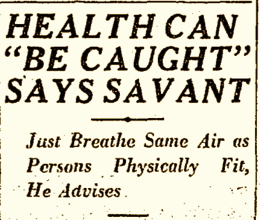Can a bar of soap between your sheets ease muscle cramps? —
Virginia news station WSLS 10 recently ran a
'myth buster' segment on whether putting a bar of soap between your sheets can ease nighttime leg and foot cramps. To my surprise, they concluded that, yes, a bar of soap does seem to help some people, even though there is "no scientific evidence" for why this would work.
Just to clarify, the claim is that merely having a bar of soap near your muscles at night can stop them from cramping. The brand of soap doesn't seem to matter much, though some people express individual preferences. (Irish Spring is a favorite.) The soap should also be in close proximity to the cramping muscle. Some people say that if cramping starts, they simply adjust their position so that the soap is making contact with the muscle, and the cramping and pain stops.
To say that there's "no scientific evidence" for this claim seems like an understatement. The idea sounds totally absurd. However, a quick google search reveals a
large number of people who, despite initial skepticism, now swear by the method. Even
Snopes lists the claim as 'undetermined'. So what could be going on here? Could soap actually have muscle-calming properties?
The most obvious theory is that the cramp relief is simply a placebo effect. People believe that it'll work, so it does. But it seems premature to dismiss the phenomenon in this way. Perhaps there is some strange bio-chemical effect at work.
Unfortunately, there's been very little scientific investigation of the soap phenomenon. The one relevant study I could find was published in the
Journal of Alternative and Complementary Medicine. Dr. Yon Doo Ough (of Beloit Memorial Hospital in Wisconsin) and colleagues investigated whether soap-scented skin patches could ease menstrual cramps. Their study was directly inspired by soap's use in preventing nocturnal leg cramps. They theorized that it was the smell of the soap, not the soap itself, that was having the antispasmodic effect. So they applied soap-scented oil to skin patches and tested them on women with a history of severe menstrual cramps. The women reported that the patches did help.
The researchers might be on to something with their scent theory. A few years ago,
over at Weird Universe, I posted about a study published in the journal
Clinical Neurology and Neurosurgery that looked at whether stinky shoe smell could be an effective treatment for epilepsy. For centuries, it's been part of folk medical practice in India to arrest epileptic seizures by forcing the person having the seizure to smell stinky shoes. The researchers concluded, to their surprise, that the technique worked. They wrote, "strong olfaction applied in the form of 'shoe-smell' did definitely play a suppressive role and thus exerted an inhibitory influence on epilepsy."
If a strong smell can suppress an epileptic seizure, perhaps it can also suppress the perception of pain and cramps. The brain works in mysterious ways. It would be interesting to test whether sleeping with a stinky shoe also eases cramps. In fact, will any strong smell have the same effect?
So until a better theory comes along, I'm willing to accept the possibility that soap between the sheets might ease cramps — perhaps because the smell somehow tricks the brain into ignoring the pain and suppressing the cramping response. Though the mystery is why applying the soap directly to the muscle seems to help. Would it be equally efficacious to put the soap directly to your nose?
As the WSLS myth-buster segment pointed out, the technique is cheap and harmless. So if you suffer from nocturnal leg cramps, I guess it's worth a try. There's nothing to lose. Though, inevitably, there are people trying to make a buck off this home remedy. Last year, one guy filed a patent for a
pain-relief "soap cushion" (depicted below) that has compartments into which pieces of hard soap can be inserted. Is that really patentable?








